Analysis of Characteristics and Driving Mechanisms of Non-Grain Production of Cropland in Mountainous Areas at the Plot Scale—A Case Study of Lechang City
Abstract
:1. Introduction
2. Theoretical Analysis and Research Framework
2.1. Theoretical Analysis
2.2. Research Framework
3. Data and Methods
3.1. Overview of the Study Area and Data Sources
3.1.1. Overview of the Study Area
3.1.2. Data Sources
3.2. Research Methods
3.2.1. Definition Criteria and Measurement Index
3.2.2. Spatial Autocorrelation
3.2.3. Kernel Density Analysis
3.2.4. Average Nearest Neighbor Index
3.2.5. Classification Criteria
3.2.6. Distribution Characteristics Index System
3.2.7. Analysis of Influencing Factors
- (1)
- Selection of influencing factors
- (2)
- Binary logistic regression
4. Analysis of Results
4.1. Clustering Characteristics
4.1.1. Clustering Characteristics from the Perspective of Villages
4.1.2. Clustering Characteristics from a Plot Perspective
4.2. Typological Features
4.3. Distribution Characteristics
4.3.1. Terrain Features
4.3.2. Location Features
4.4. Driving Mechanisms
5. Discussions
5.1. Research Discussion
5.2. Recommendations for Countermeasures
- (1)
- Optimize cropland irrigation facilities to enhance the quality of cropland
- (2)
- Promote mechanized production suitable for the local conditions to enhance the efficiency of grain cultivation
- (3)
- Improving the agricultural production structure promotes the sustainable development of cropland in mountainous areas.
6. Conclusions
- (1)
- In Lechang City, 34.92% of cropland across the entire area is used for non-grain production. At the village level, villages with larger areas of NGPCL are locally clustered in the southwest of Lechang City, while villages with higher degrees of NGPCL are mainly clustered in the central part of Lechang City. At the plot level, compared to the plots for non-grain production, the plots for food-growing tend to be more clustered spatially. Regarding the plots for non-grain production, terraces exhibit the most significant dispersion pattern, followed by slope cropland, and finally plains. For the plots for food-growing, slope cropland shows the most significant dispersion pattern, while plains exhibit the highest degree of clustering.
- (2)
- In terms of irrigation types, the largest scale of NGPCL occurs in dry land, followed by paddy fields, and, finally, irrigated land. However, the highest degree of NGPCL is observed in irrigated land, followed by dry land, and then paddy fields. Regarding terrain classification, terraces have the largest scale of NGPCL, while the scales of plains and slope cropland are roughly similar. The highest degree of NGPCL is observed in slope cropland, followed by terraces, and finally plains.
- (3)
- NGPCL exhibits clear preferences for topography and location. The greater the slope, elevation, and difference in altitude from the settlement, the more likely NGPCL occurs. Additionally, NGPCL is more likely to occur in areas farther from settlements, farther from roads, and closer to forests.
- (4)
- Apart from the three variables of annual temperature, distance from settlement, and distance to forest, all other variables significantly influence NGPCL. Elevation, cropland quality, plot connectivity, and plot shape index all affect the profitability of grain production, serving as negative drivers for NGPCL. Difference in altitude from the settlement, distance to road, slope, and precipitation all impact the cost of grain production, exerting positive effects on NGPCL. NGPCL is primarily the production choice of farmers aiming to pursue higher profits. Various influencing factors primarily affect the costs and revenues of grain production, thereby driving farmers to change their production patterns and initiate NGPCL.
Author Contributions
Funding
Institutional Review Board Statement
Informed Consent Statement
Data Availability Statement
Conflicts of Interest
References
- Lan, Y.; Xu, B.; Huan, Y.; Guo, J.; Liu, X.; Han, J.; Li, K. Food Security and Land Use under Sustainable Development Goals: Insights from Food Supply to Demand Side and Limited Arable Land in China. Foods 2023, 12, 4168. [Google Scholar] [CrossRef] [PubMed]
- Li, J.; Xiao, Q.; Wu, H.; Li, J. Unpacking the Global Rice Trade Network: Centrality, Structural Holes, and the Nexus of Food Insecurity. Foods 2024, 13, 604. [Google Scholar] [CrossRef] [PubMed]
- Ray, D.K.; Sloat, L.L.; Garcia, A.S.; Davis, K.F.; Ali, T.; Xie, W. Crop harvests for direct food use insufficient to meet the UN’s food security goal. Nat. Foods 2022, 3, 367–374. [Google Scholar] [CrossRef] [PubMed]
- Li, X.; Sun, Z.; Zhao, Y. Global Food Security and Its Governance: Development Process, Practical Challenges and Transformation Strategies. Chin. Rural Econ. 2022, 40, 2–22. [Google Scholar]
- Chen, W.; Cai, W.; Zhang, C.; Zhou, W.; Che, X.; Zhang, X.; Liu, Z.; Zeng, J.; Wang, G. Analysis of Spatiotemporal Pattern of Global Grain Security Risks. Chin. J. Agric. Resour. Reg. Plan. 2023, 44, 38–51. [Google Scholar]
- Bian, J. A Study on the Main Impact of the Global Food Security Situation Changes on China and Its Coping Strategies. Macroeconomics 2022, 46, 140–151. [Google Scholar]
- Wang, J.; Dai, C. Identifying the Spatial–Temporal Pattern of Cropland’s Non-Grain Production and Its Effects on Food Security in China. Foods 2022, 11, 3494. [Google Scholar] [CrossRef] [PubMed]
- Cui, X.; Zhong, Z. Climate change, cropland adjustments, and food security: Evidence from China. J. Dev. Econ. 2024, 167, 103245. [Google Scholar] [CrossRef]
- Han, M.; Li, S. Transfer patterns and drivers of embodied agricultural land within China: Based on multi-regional decomposition analysis. Land 2021, 10, 213. [Google Scholar] [CrossRef]
- Zhu, J.; Wang, R.; Cao, L. World Food Market Volatility and China’s Food Security under the Russia–Ukraine Conflict. Soc. Sci. J. 2023, 46, 158–168. [Google Scholar]
- Zhu, X.; Li, C.; Zhou, H. Cost Changes and Technical Efficiency of Grain Production in China against a Background of Rising Factor Prices. Sustainability 2022, 14, 12852. [Google Scholar] [CrossRef]
- Wang, C.; Liang, X.; Dou, H.; Huang, Y. Spatio-temporal Evolution and Driving Mechanism of Non-grain Cultivated Land for Rural Multi-value Realization: A Case Study of Chongqing. Econ. Geogr. 2023, 43, 144–153. [Google Scholar]
- Su, S.; Zhou, X.; Wan, C.; Li, Y.; Kong, W. Land use changes to cash crop plantations: Crop types, multilevel determinants and policy implications. Land Use Policy 2016, 50, 379–389. [Google Scholar] [CrossRef]
- Cheng, X.; Liu, Q.; Tao, Y.; Liu, J.; Wang, F.; Tao, Q.; Ou, W. Non-grain production characteristics of cultivated land in rapidly urbanized regions and their mechanisms. China Popul. Resour. Environ. 2022, 32, 172–182. [Google Scholar]
- Henchion, M.; Hayes, M.; Mullen, A.M.; Fenelon, M.; Tiwari, B. Future Protein Supply and Demand: Strategies and Factors Influencing a Sustainable Equilibrium. Foods 2017, 6, 53. [Google Scholar] [CrossRef] [PubMed]
- Ye, S.; Song, C.; Cheng, C.; Gao, P.; Shen, S.; Mu, W. Five issues and countermeasures of China cropland resource use. Bull. Chin. Acad. Sci. 2023, 38, 1962–1976. [Google Scholar]
- Feng, Z.; Xiao, C.; Li, P. Spatio-temporal Pattern Changes of Cereal Production and Trade in China-ASEAN Free Trade Area. J. Nat. Resour. 2017, 32, 937–950. [Google Scholar]
- Yu, H.; Li, K. Global Food Security Governance and China’s Participation. J. Int. Stud. 2021, 42, 83–103+7. [Google Scholar]
- Huang, J.; Wei, W.; Qi, C.; Wei, X. The prospects for China’s food security and imports: Will China starve the world via imports? J. Integr. Agric. 2017, 16, 2933–2944. [Google Scholar] [CrossRef]
- Kong, X. Problems, causes and countermeasures of “non-grain” production of arable land. China Land 2020, 43, 17–19. [Google Scholar]
- Li, T.; Hao, D. Current situation of “non-grain production” of cultivated land in China and the research progress of re-tillage and fertilization technology. Chin. J. Appl. Ecol. 2023, 34, 1703–1712. [Google Scholar]
- Liu, Z.; Yang, P.; Wu, W.; You, L. Spatiotemporal changes of cropping structure in China during 1980–2011. J. Geogr. Sci. 2018, 28, 1659–1671. [Google Scholar] [CrossRef]
- Wang, S.; Ma, L. Impact of non-grain utilization of cultivated land on the technical efficiency of grain production and regional differences in major grain-consuming areas: A case study of Guangdong Province. J. China Agric. Univ. 2023, 28, 38–51. [Google Scholar]
- Li, L.; Hu, X.; Chen, S. Characteristics of China’s Grain Production and Grain Security Policy Orientation in the New Century. Macroeconomics 2023, 46, 70–83. [Google Scholar]
- Pan, J.W.; Chen, Y.; Zhang, Y.; Chen, M.; Fennell, S.; Luan, B.; Wang, F.; Meng, D.; Liu, Y.; Jiao, L.; et al. Spatial–temporal dynamics of grain yield and the potential driving factors at the county level in China. J. Clean. Prod. 2020, 255, 120312. [Google Scholar] [CrossRef]
- Cámara, M.C.; Albuquerque, J.P.; Suchomska, J.; Tregonning, G.; McInerny, G. Co-designing grounded visualisations of the Food–Water–Energy nexus to enable urban sustainability transformations. Environ. Sci. Policy 2024, 154, 103712. [Google Scholar] [CrossRef]
- Kim, H.J.; Lazurko, A.; Linney, G.; Maskell, L.; Díaz-General, E.; Březovská, R.J.; Harrison, P.A. Understanding the role of biodiversity in the climate, food, water, energy, transport and health nexus in Europe. Sci. Total Environ. 2024, 925, 171692. [Google Scholar] [CrossRef] [PubMed]
- Chapagain, K.; Babel, M.S.; Karthe, D.; Stamm, J. Integrated assessment of water–energy–food nexus: Conceptual framework and application to the Ping River basin, Thailand. Int. J. Water Resour. Dev. 2024, 40, 284–318. [Google Scholar] [CrossRef]
- Luo, B.; Jiang, X.; Li, S.; Chou, T. Will the transfer of agricultural land lead to a “non-grain” planting structure. Jianghai Acad. J. 2018, 61, 94–101+238. [Google Scholar]
- Chen, F.; Liu, J.; Chang, Y.; Zhang, Q.; Yu, H.; Zhang, S. Spatial Pattern Differentiation of Non-grain Cultivated Land and Its Driving Factors in China. China Land Sci. 2021, 35, 33–43. [Google Scholar]
- Liang, X.; Xiao, B.; Liu, J.; Yin, Y.; Gu, Z.; Zhang, J.; Zhou, Y. Formation mechanism and sustainable productivity impacts of non-grain croplands: Evidence from Sichuan Province, China. Land Degrad. Dev. 2022, 34, 1120–1132. [Google Scholar] [CrossRef]
- Wu, D.; Wu, Z.; Li, S.; Liang, Y.; Ma, P.; Li, Z.; Lin, T. Spatiotemporal Evolution and Influencing Factors of Non-grain Cultivated Land in Northern Mountainous Areas of Guangdong Province. Econ. Geogr. 2023, 43, 144–153. [Google Scholar]
- Ren, G.; Song, G.; Wang, Q.; Sui, H. Impact of “Non-Grain” in Cultivated Land on Agricultural Development Resilience: A Case Study from the Major Grain-Producing Area of Northeast China. Appl. Sci. 2023, 13, 3814. [Google Scholar] [CrossRef]
- Zhang, J.; Liu, Y.; Zhang, E.; Chen, J.; Tan, Q. Dynamics and driving mechanisms of cultivated land at county level in China. Acta Geogr. Sin. 2023, 78, 2105–2127. [Google Scholar]
- Hou, M.; Deng, Y.; Yao, J. Coordinated relationship between urbanization and grain production in China: Degree measurement, spatial differentiation and its factors detection. J. Clean. Prod. 2022, 331, 129957. [Google Scholar] [CrossRef]
- Wang, S.; Tian, X. The Influence of Rural Labor Force Aging on Agricultural Production—An empirical analysis of cultivated land terrain. J. Agrotech. Econ. 2018, 37, 15–26. [Google Scholar]
- Zhang, B.; Gao, J.; Gao, Y.; Cai, W.; Zhang, F. Land use transition of mountainous rural areas in China. Acta Geogr. Sin. 2018, 73, 503–517. [Google Scholar]
- Zhou, S.; Li, X. The study of the influence of input price increase on the input adoption structure: A case study of peanut production in China. Res. Agric. Mod. 2020, 41, 125–134. [Google Scholar]
- Ren, C.; Zhou, X.; Wang, C.; Guo, Y.; Diao, Y.; Shen, S.; Reis, S.; Li, W.; Xu, J.; Gu, B. Ageing threatens sustainability of smallholder farming in China. Nature 2023, 616, 96–103. [Google Scholar] [CrossRef]
- Zhao, X.; Liu, Z. “Non-Grain” or “Grain-Oriented”: An Analysis of Trend of Farmland Management. J. South China Agric. Univ. (Soc. Sci. Ed.) 2021, 20, 78–87. [Google Scholar]
- Wang, S.; Ye, X. Negative Externality of De-grainization of Arable Land and Its Countermeasures. Rural Econ. 2023, 42, 1–10. [Google Scholar]
- Su, Y.; Li, C.; Wang, K.; Deng, J.; Shahtahmassebi, A.R.; Zhang, L.; Ao, W.; Guan, T.; Pan, Y.; Gan, M. Quantifying the spatiotemporal dynamics and multi-aspect performance of non-grain production during 2000–2015 at a fine scale. Ecol. Indic. 2019, 101, 410–419. [Google Scholar] [CrossRef]
- Zhao, Z.; Zheng, T.; Zhao, X.; Pu, J.; Lu, F. Non-point Source Pollutants Loss of Planting Industry in the Yunnan Plateau Lake Basin, China. J. Agric. Resour. Environ. 2018, 35, 40–47. [Google Scholar]
- Hao, L.; Yu, J.; Wang, P.; Han, C. Analysis of the water-energy-food nexus system for sustainable development and its research framework. Prog. Geogr. 2023, 42, 173–184. [Google Scholar] [CrossRef]
- Zhong, T.; Si, Z.; Shi, L.; Ma, L.; Liu, S. Impact of state-led food localization on suburban districts’ farmland use transformation: Greenhouse farming expansion in Nanjing city region, China. Landsc. Urban Plan. 2020, 202, 103872. [Google Scholar] [CrossRef]
- Chen, X.; Xin, G.; Wei, C. An Analysis of Farmland Abandonment in Poor Mountainous Areas and Its Influencing Factors—A Case Study of Four Villages in Two Twonships of Youyang County, Chongqing. J. Southwest Univ. (Nat. Sci. Ed.) 2016, 38, 166–174. [Google Scholar]
- Wang, K.; Xiao, W.; Yu, C.; Chen, H.; Tan, Y. Research status and prospects of the cultivated land marginalization in China. J. China Agric. Univ. 2023, 28, 183–194. [Google Scholar] [CrossRef]
- Yu, H.; Niu, Z. “Non Grain Conversion” of Farmland: Connotation, Essence, Governance Constraints, and Path Selection. Rural Econ. 2023, 42, 1–10. [Google Scholar]
- Chen, K.; Long, H.; Liao, L.; Tu, S.; Li, T. Land use transitions and urban-rural integrated development: Theoretical framework and China’s evidence. Land Use Policy 2020, 92, 104465. [Google Scholar] [CrossRef]
- Cao, Y.; Li, G.; Wang, J.; Fang, X.; Sun, K. Systematic Review and Research Framework of “Non-grain” Utilization of Cultivated Land: From a Perspective of Food Security to Multi-dimensional Security. China Land Sci. 2022, 36, 1–12. [Google Scholar]
- Yang, Q.; Xin, G.; Jiang, J.; Chen, Z. Practices of Cropland Fallowing Systems in Europe, America and East Asia: Comparison and Implications. China Land Sci. 2017, 31, 71–79. [Google Scholar]
- Zhang, D.; Yang, W.; Kang, D.; Zhang, H. Spatial-temporal characteristics and policy implication for non-grain production of cultivated land in Guanzhong Region. Land Use Policy 2023, 125, 106466. [Google Scholar] [CrossRef]
- Almohamad, H.; Knaack, A.L.; Habib, B.M. Assessing spatial equity and accessibility of public green spaces in Aleppo City, Syria. Forests 2018, 9, 706. [Google Scholar] [CrossRef]
- Ma, L. Rational Smallholder or Survival Smallholder—Critique and Reflection of the Entity Smallholder School on the Formal Smallholder School. Soc. Sci. Front. 2014, 37, 165–172. [Google Scholar]
- Feng, M.; Pan, H.; Zhu, F.; Fang, L. Spatial Pattern of Different Abandoned Farmland and Its Affecting Factors: Taking Zhongjiang District, Deyang City as Example. Southwest China J. Agric. Sci. 2018, 31, 1260–1266. [Google Scholar]
- Lu, Z.; Pan, X.; Zhou, G.; Tang, Z.; Li, X.; Guo, Y.; Huang, J.; Zhuang, D. Study on the Characteristics and Influencing Factors of Farmland Marginalization in Suburban Rural Areas of Metropolis: A Survey of Rural Households in Suburban Areas of Guangzhou City. China Land Sci. 2021, 35, 67–74. [Google Scholar]
- Wu, Y.; Yun, W.; Zhou, R. Productivity calculation methods and distribution regulation based on cultivated land quality appraisal. Trans. Chin. Soc. Agric. Eng. 2008, 24, 85–89. [Google Scholar]
- Zheng, X.; Xu, Z. Resource endowment constraints, factor substitution and induced technological change—The case of mechanisation of grain production in China. China Econ. Q. 2017, 16, 45–66. [Google Scholar]
- Chen, W.; Liao, Y.; Kong, X.; Lei, M.; Wen, L.; Zhang, B. Characteristics, Drivers and Control of Non-grain Production on Permanent Basic Farmland Based on Plot Scale. Trans. Chin. Soc. Agric. Mach. 2023, 54, 114–124. [Google Scholar]
- Shao, J.; Zhang, S.; Li, X. Farmland marginalization in the mountainous areas: Characteristics, influencing factors and policy implications. Acta Geogr. Sin. 2014, 69, 227–242. [Google Scholar] [CrossRef]
- Long, M.; Zhao, Y.; Zhang, D. Impacts of mountainous land fragmentation on cultivated land abandonment of farmers. Trans. Chin. Soc. Agric. Eng. 2022, 38, 231–239. [Google Scholar]
- Zhang, T.; Zheng, Y.; Zhang, F.; Huang, J.; Chang, Y. Analysis of the factors affecting abandoned terraces in mountainous areas from the perspective of engineering design. Trans. Chin. Soc. Agric. Eng. 2020, 36, 276–283. [Google Scholar]
- Mou, Y.; Zhao, Y.; Li, X.; Ren, Y.; Liu, Y. The influence of plot quality characteristics on terrace abandonment in mountainous areas of Southwest China: A case study of Baidu Village in Jianhe County, Guizhou Province. Geogr. Res. 2022, 41, 903–916. [Google Scholar]
- He, X.; Zhong, J.; Lin, S.; Dai, R.; He, Z.; Shi, G. Characteristics and driving mechanism of spatial differentiation of “Non-grain” cultivated land in karst trough valley area: Taking Wanshan District, Tongren, Guizhou as an example. Sci. Geogr. Sin. 2022, 42, 2207–2217. [Google Scholar]
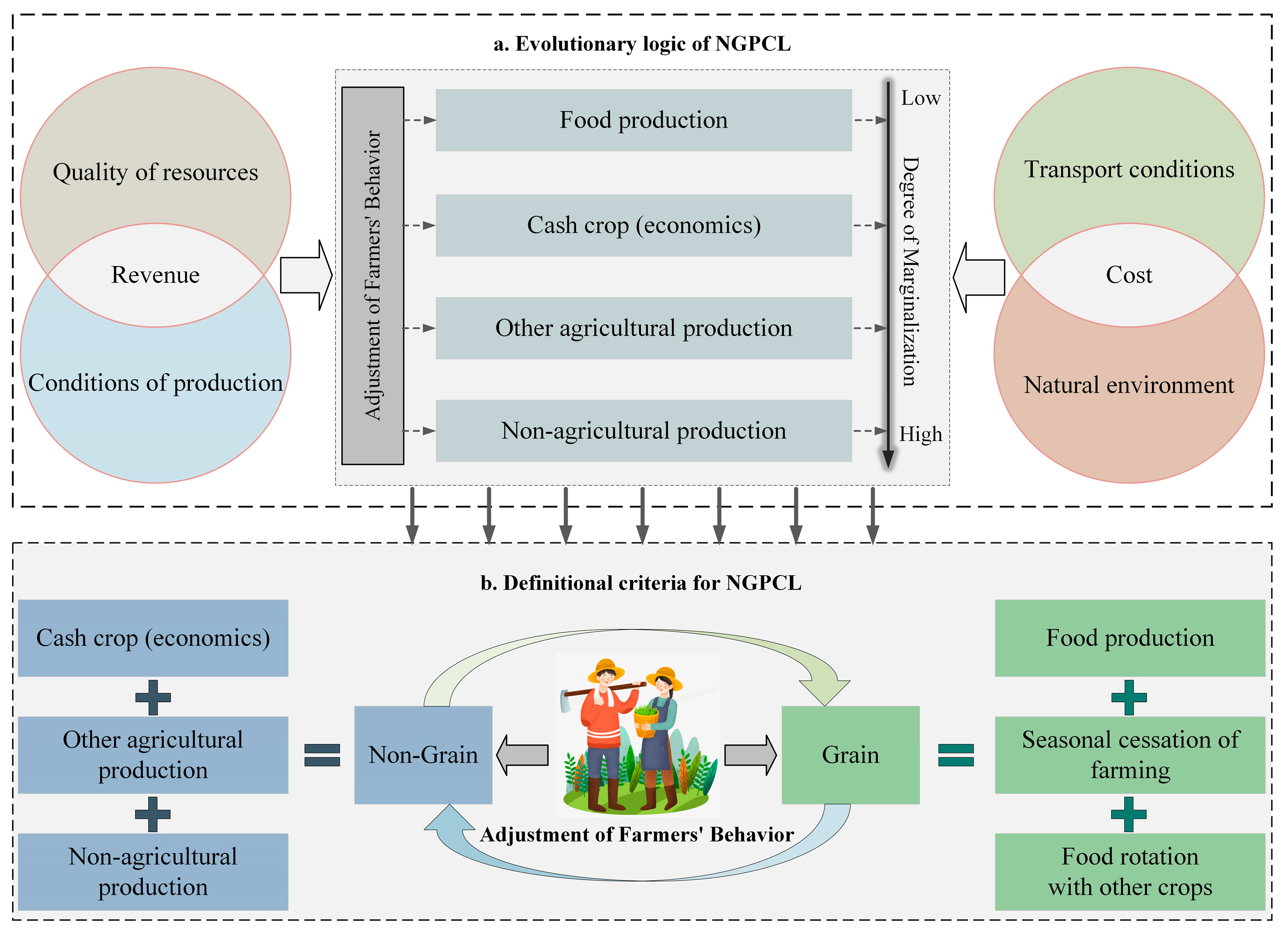
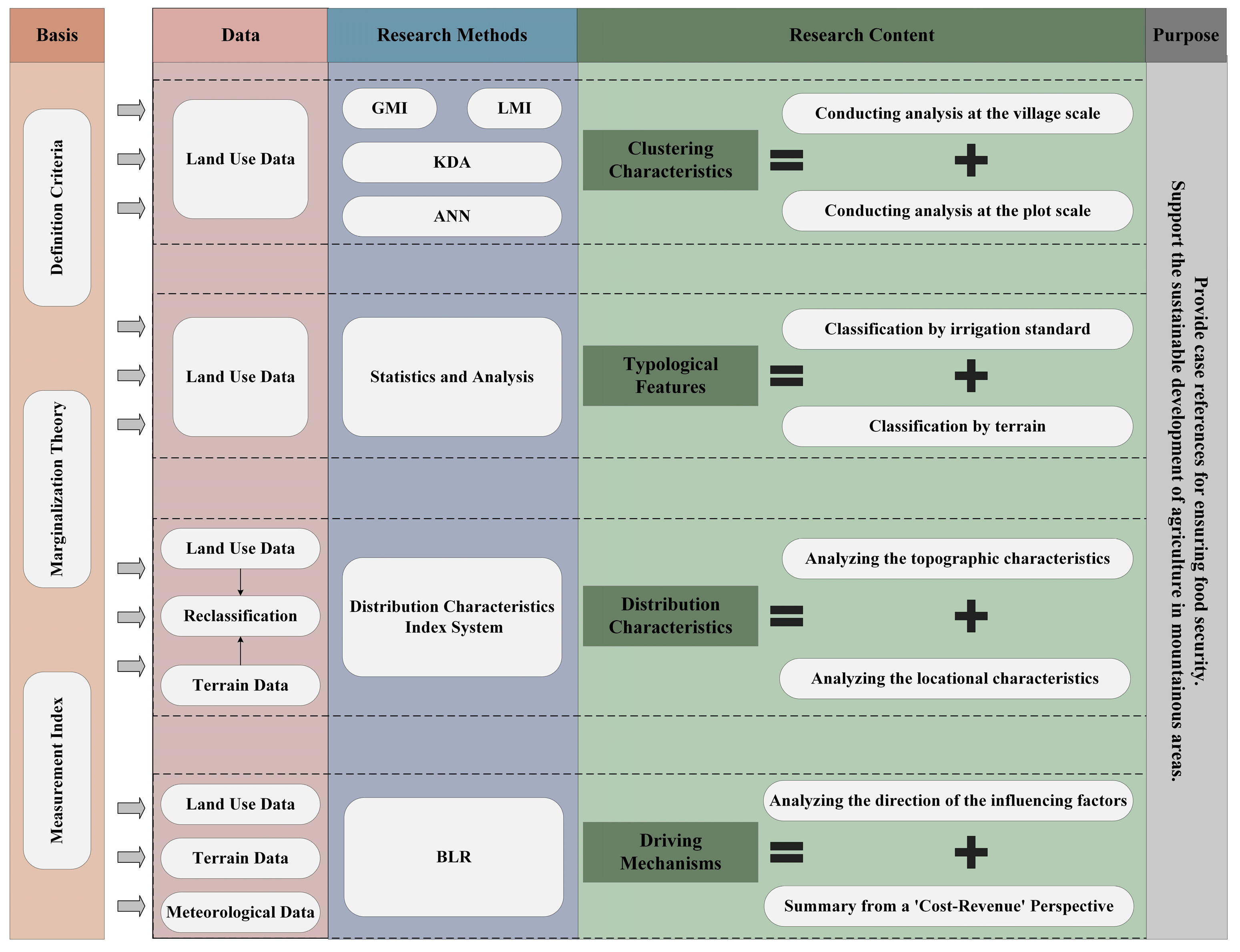

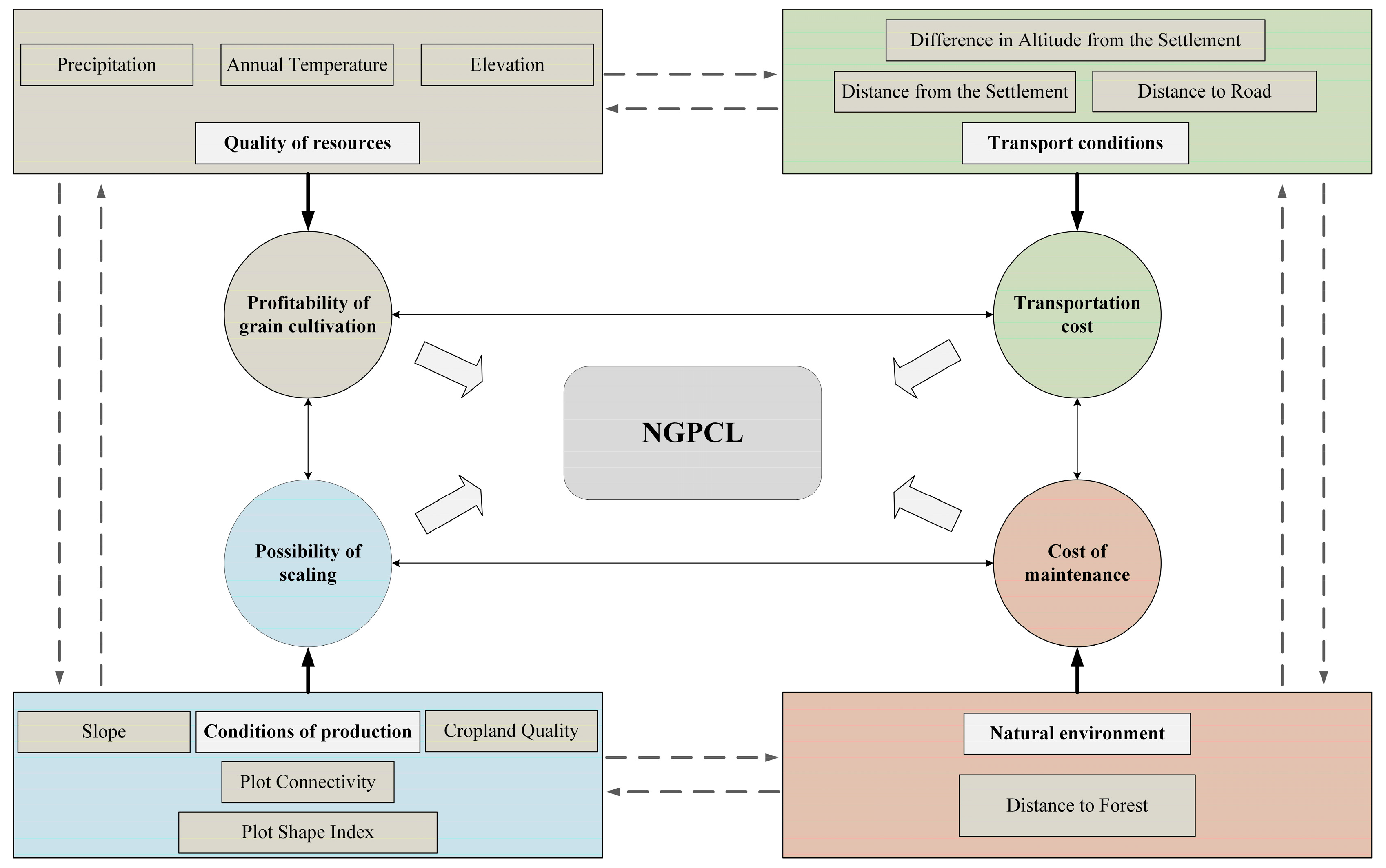
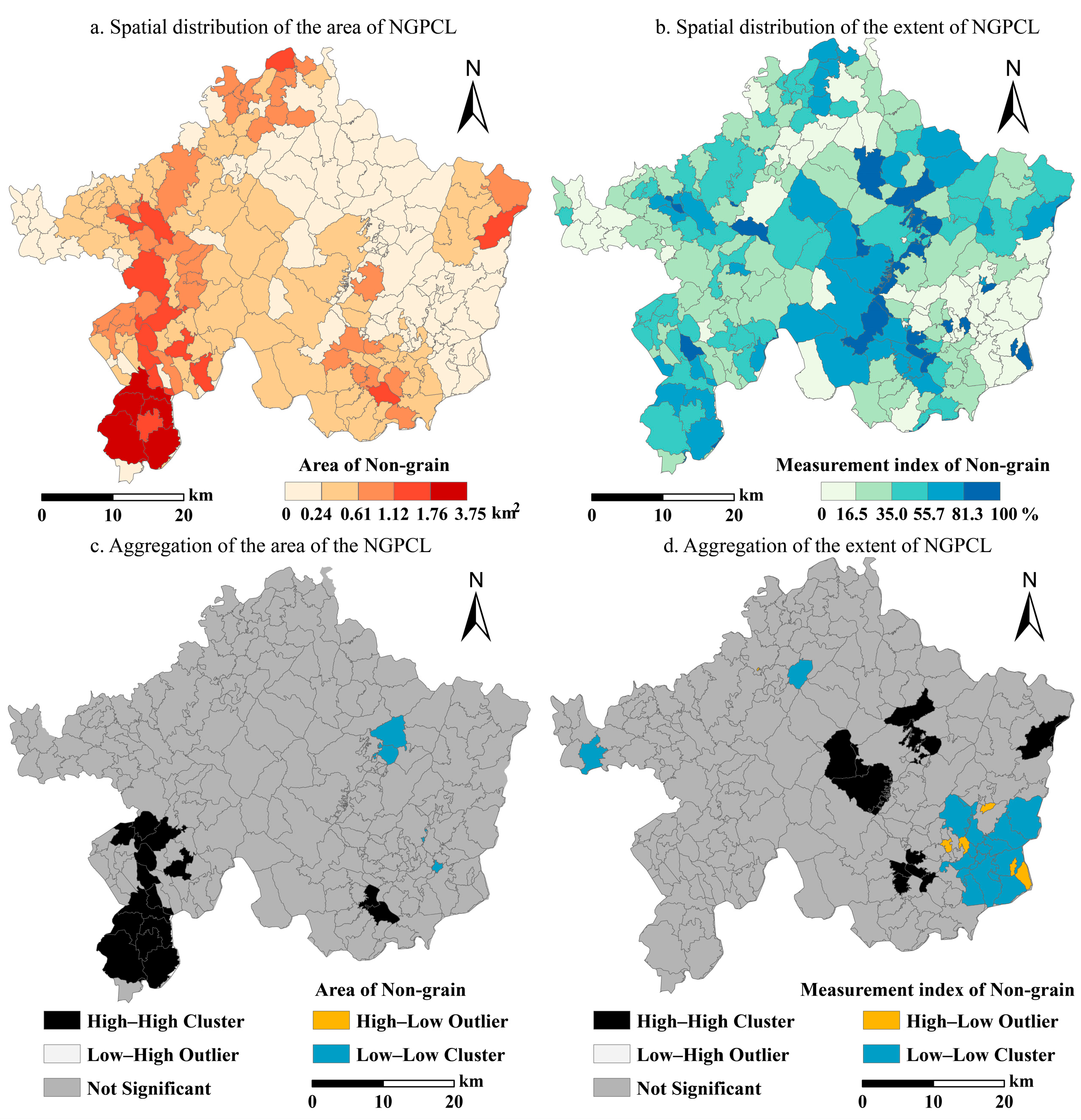
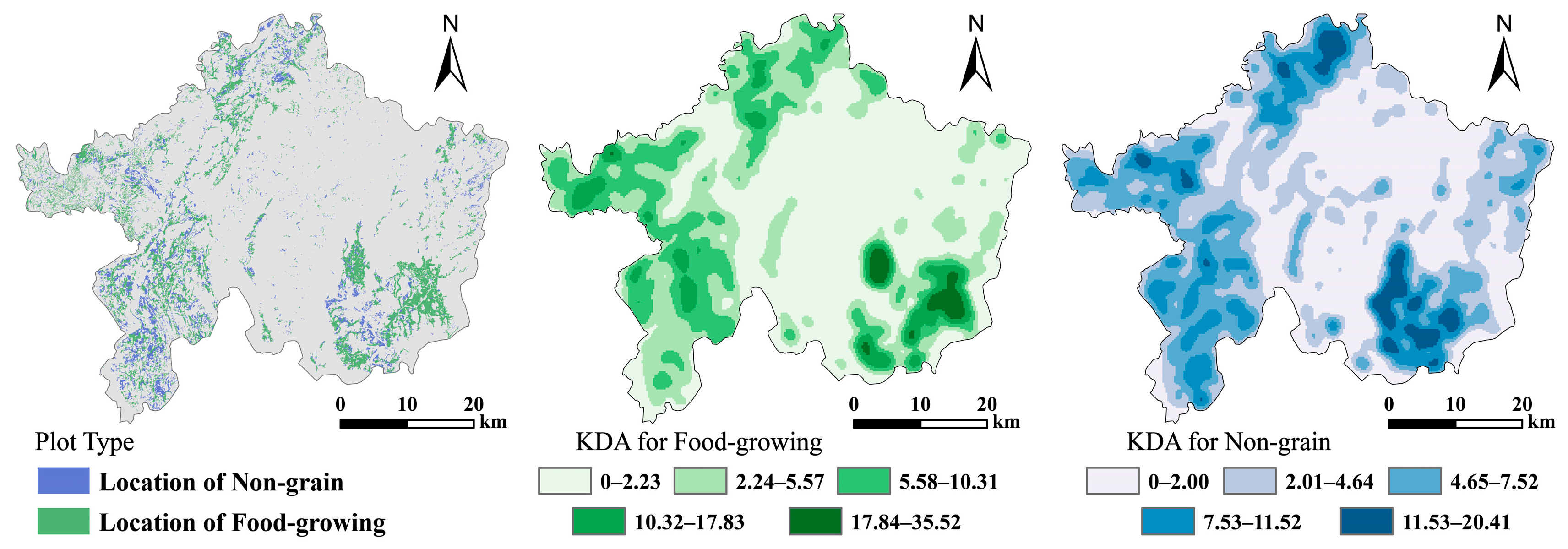
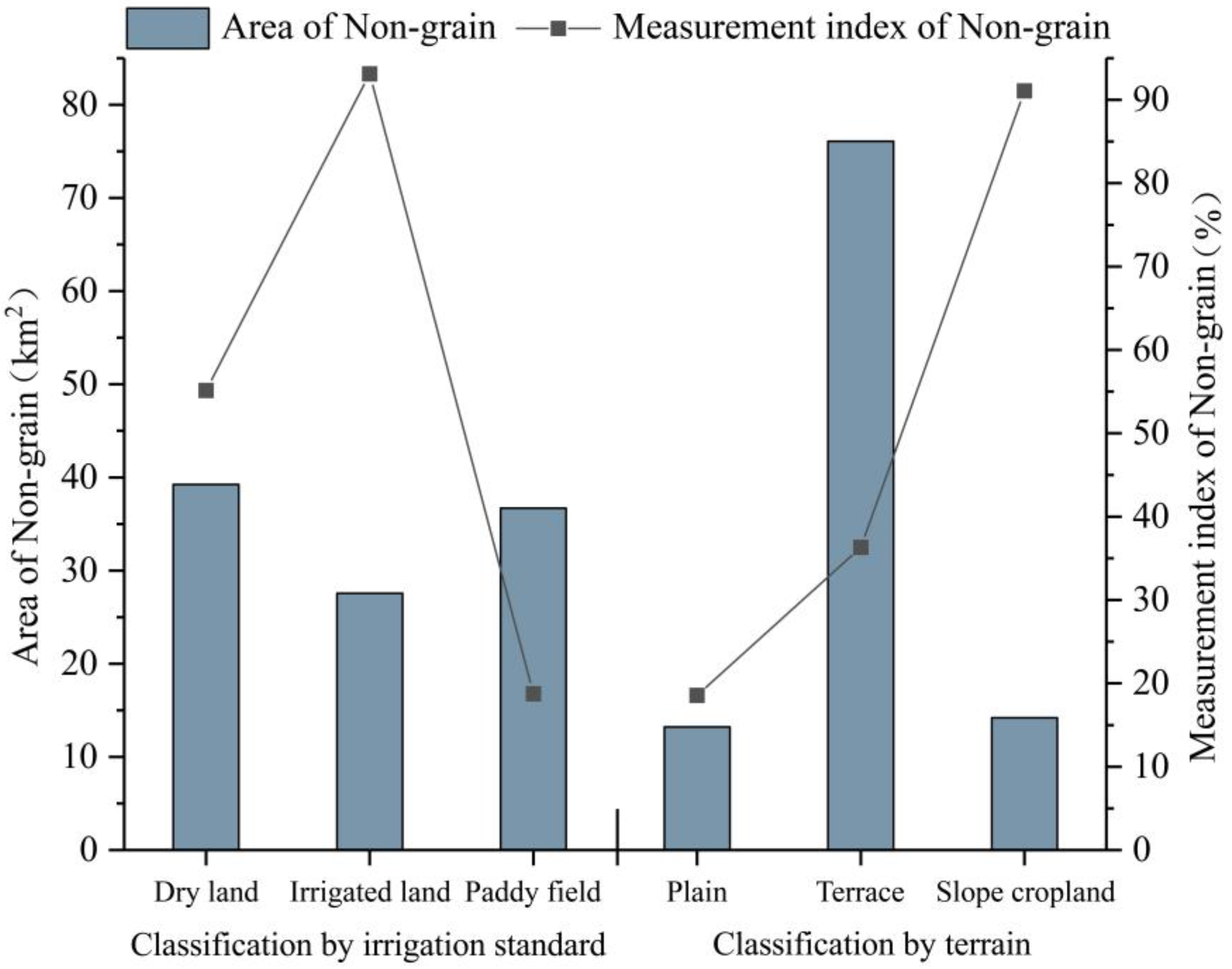

| Data Source | Data Name | Variable Content |
|---|---|---|
| Land Survey Data | Cropland Plot Data | 0 = Planted with crops, 1 = Cropland used for non-grain production |
| Difference in Altitude from the Settlement | Difference in altitude between the plot and the nearest residential area. Measured in meters | |
| Distance from the Settlement | Distance from the plot to the nearest residential area. Measured in meters | |
| Distance to Road | Distance from the plot to the nearest road. Measured in meters | |
| Plot Connectivity | Area size of the individual plot. Measured in square meters | |
| Plot Shape Index | Geometric shape of the plot with reference to a square. Calculated as 0.25 × perimeter/area (power, 0.5) | |
| Distance to Forest | Distance from the plot to the nearest forest patch. Measured in meters | |
| ASTER GDEM | Elevation | Average elevation of cropland measured per plot. Measured in meters |
| Slope | Slope of the cropland plot | |
| ERA5 | Annual Temperature | Sum of daily average temperatures accumulated per plot over one year. Measured in degrees Celsius |
| Precipitation | Total daily precipitation sum, averaged over one year. Measured in millimeters | |
| Cropland Quality Annual Update | Cropland Quality | Indicator based on organic matter content. Measured in grams |
| Classification Criteria | Types of Croplands | Content |
|---|---|---|
| Classification by irrigation standard | Dry land | Cropland that relies solely on natural precipitation to provide water for crops |
| Irrigated land | Cropland near natural reservoirs but highly susceptible to the impact of natural rainfall | |
| Paddy field | Cropland with artificial irrigation water supply | |
| Classification by terrain | Slope cropland | Cropland distributed on slopes with poor flatness and severe soil erosion |
| Terrace | Terraced fields constructed along contour lines on hillsides, featuring strip-shaped terrace or undulating cross-sectional profiles. | |
| Plain | Flat farmland with a relatively level terrain. |
| Category | Variable Name | Data Processing |
|---|---|---|
| Terrain Features | Slope | Slope < 2° assigned 1, 2–6° assigned 2, 6–15° assigned 3, 15–25° assigned 4, >25° assigned 5 |
| Elevation | Every 100 m is one level, with 10 levels above 900 m | |
| Difference in Altitude from the Settlement | Levels 1–2, every 5 m within; levels 3–6, every 10 m within; Level 7: (50–100 m); Level 8: (100 m or more) | |
| Location Features | Distance from the Settlement | Within levels 1–3, every 300 m is one level; within levels 4–6, every 600 m is one level; Level 7 is 2700 m or more |
| Distance to Road | Within levels 1–5, every 100 m is one level; within levels 6–8, every 500 m is one level; Level 9 is 2000 m or more | |
| Distance to Forest | Level 1 distance is 0 m; within levels 2–11, every 10 m is one level; within levels 12–14, every 50 m is one level; Level 14 is 200 m or more |
| Types/Hierarchy | Extremely Low | Low | Medium | High | Extremely High |
|---|---|---|---|---|---|
| Area (km2) | (0, 0.24] | (0.24, 0.61] | (0.61, 1.12] | (1.12, 1.76] | (1.76, 3.75] |
| Proportions (%) | (0, 16.5] | (16.5, 35.0] | (35.0, 55.7] | (55.7, 81.3] | (81.3, 100] |
| Typology | I-Value | p-Value | Z-Value | Variance |
|---|---|---|---|---|
| Area of NGPCL | 0.315 | 0.00 * | 9.743 | 0.001 |
| Measurement index of NGPCL | 0.298 | 0.00 * | 8.998 | 0.001 |
| Production Status | Type of Cropland | Expected Distance | Observed Distance | ANN Index | Z-Value | p-Value |
|---|---|---|---|---|---|---|
| Plots for non-grain production | All plots | 168.566 | 314.391 | 0.536 | −88.374 | 0.00 * |
| Plain | 266.397 | 802.350 | 0.332 | −47.968 | 0.00 * | |
| Terrace | 208.404 | 389.218 | 0.535 | −71.492 | 0.00 * | |
| Slope cropland | 356.379 | 674.680 | 0.528 | −40.755 | 0.00 * | |
| Plots for food-growing | All plots | 168.681 | 322.870 | 0.522 | −87.620 | 0.00 * |
| Plain | 177.699 | 544.644 | 0.326 | −63.288 | 0.00 * | |
| Terrace | 199.179 | 383.105 | 0.520 | −74.236 | 0.00 * | |
| Slope cropland | 1174.452 | 1823.145 | 0.644 | −10.848 | 0.00 * |
| Omnibus: p = 0.00 * | ||||||
|---|---|---|---|---|---|---|
| Variable Type | Variable Name | B-Value | Standard Error | p-Value | VIF | EXP(B) |
| Quality of resources | Elevation | −0.119 | 0.018 | 0.00 * | 7.821 | 0.888 |
| Annual Temperature | 0.000 | 0.000 | 0.770 | 6.327 | 1.000 | |
| Precipitation | 0.003 | 0.000 | 0.00 * | 1.550 | 1.003 | |
| Transport conditions | Difference in Altitude from the Settlement | 0.068 | 0.010 | 0.00 * | 1.640 | 1.070 |
| Distance from the Settlement | 0.004 | 0.011 | 0.736 | 1.343 | 1.004 | |
| Distance to Road | 0.065 | 0.014 | 0.00 * | 1.368 | 1.067 | |
| Conditions of production | Cropland Quality | −0.106 | 0.012 | 0.00 * | 2.075 | 0.900 |
| Slope | 0.329 | 0.022 | 0.00 * | 2.390 | 1.389 | |
| Plot Connectivity | −13.827 | 0.832 | 0.00 * | 1.316 | 0.000 | |
| Plot Shape Index | −0.217 | 0.033 | 0.00 * | 1.269 | 0.805 | |
| Natural environment | Distance to Forest | 0.012 | 0.005 | 0.034 | 1.900 | 1.012 |
| Constant | −3.470 | 0.619 | 0.00 * | — | 0.031 | |
Disclaimer/Publisher’s Note: The statements, opinions and data contained in all publications are solely those of the individual author(s) and contributor(s) and not of MDPI and/or the editor(s). MDPI and/or the editor(s) disclaim responsibility for any injury to people or property resulting from any ideas, methods, instructions or products referred to in the content. |
© 2024 by the authors. Licensee MDPI, Basel, Switzerland. This article is an open access article distributed under the terms and conditions of the Creative Commons Attribution (CC BY) license (https://creativecommons.org/licenses/by/4.0/).
Share and Cite
Wu, Z.; Li, S.; Wu, D.; Song, J.; Lin, T.; Gao, Z. Analysis of Characteristics and Driving Mechanisms of Non-Grain Production of Cropland in Mountainous Areas at the Plot Scale—A Case Study of Lechang City. Foods 2024, 13, 1459. https://doi.org/10.3390/foods13101459
Wu Z, Li S, Wu D, Song J, Lin T, Gao Z. Analysis of Characteristics and Driving Mechanisms of Non-Grain Production of Cropland in Mountainous Areas at the Plot Scale—A Case Study of Lechang City. Foods. 2024; 13(10):1459. https://doi.org/10.3390/foods13101459
Chicago/Turabian StyleWu, Zhaojun, Shengfa Li, Dafang Wu, Jun Song, Tong Lin, and Ziya Gao. 2024. "Analysis of Characteristics and Driving Mechanisms of Non-Grain Production of Cropland in Mountainous Areas at the Plot Scale—A Case Study of Lechang City" Foods 13, no. 10: 1459. https://doi.org/10.3390/foods13101459
APA StyleWu, Z., Li, S., Wu, D., Song, J., Lin, T., & Gao, Z. (2024). Analysis of Characteristics and Driving Mechanisms of Non-Grain Production of Cropland in Mountainous Areas at the Plot Scale—A Case Study of Lechang City. Foods, 13(10), 1459. https://doi.org/10.3390/foods13101459






